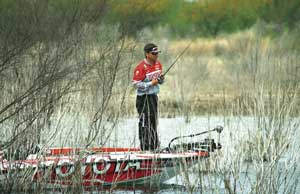
The spring is one of the best times of the year to catch bass, with fish up shallow and aggressively protecting their spawning beds. Anglers simply love picking big sows off the nests.
And then the fish just seem to disappear. For a few weeks after the spawn peters out, fishermen struggle to put bass in their boats.
So Louisiana Sportsman asked a handful of pros — who have to produce no matter the time of year — about how they approach post-spawn fishing. Here are their thoughts, techniques and lure choices.
Gary Klein
This Bassmaster Elite Series pro said anglers often intimidated by the changes brought about by the end of the spawn need to access the waters in which they are fishing to be able to effectively target post-spawn bass.
“There are four types of water: manmade reservoirs, natural bodies of water, current-influenced waters and tidal areas,” Klein said.
The two-time BASS Angler of the Year said that fish behave differently on each of these waters.
For example, bass in deep man-made reservoirs like Toledo Bend don’t hang around in the shallows long after they drop their eggs.
“When the fish come off the beds is when I find them moving to the deepest parts of the lake,” Klein said. “The thermocline hasn’t developed, and for some reason, the sows want to lay their eggs and just get away from it all.
“They go to these deep-water refuges.”
That could account for many North Louisiana angler’s difficulties in finding bass after the spawn — they simply don’t look deep enough.
Klein said it’s fairly easy to find bass once you understand their pattern of movement.
“You can look into the bays and see the major spawning areas,” he said. “What I try to do with my electronics and topo maps is find the routes the fish use to into the shallows and out again after the spawn.”
That simply means locating old creek channels or ditches leading from the spawning flats, he said.
“I’ll follow them all the way out to the main channel,” Klein said.
That’s where the fish will be suspended on drops, on the ends of deep points and around humps as they shake off the effects of several weeks of spawning.
Because they’re so deep, one bait stands out as Klein’s post-spawn favorite for man-made reservoirs.
“This is one of the best times of the year to fish a big crankbait,” he explained. “I’m throwing 14-foot, 20-foot, 25-foot models.”
But it’s not just a matter of casting and reeling big-lipped cranks, he said.
“Depth and speed are most critical,” Klein said.
Cast distance is key to achieving the maximum depth with a crankbait.
“That’s why we have invented crankbaits that are so big — the weight allows you to make long casts,” he explained.
Speed of retrieve can make the difference between getting a workout and battling fish to the boat.
“Probably the worst thing I see fishermen do with a big crankbait is reeling too fast,” Klein said. “Big crankbaits will go deeper if (anglers) keep a slow, steady pace with them.”
The slower retrieve also relieves some of the fatigue many associate with reeling in these huge baits, he said.
One other important tip for deepwater cranks is to include a change of direction in the retrieve, Klein said.
“We bang them into brush or rocks or pilings, and that triggers bites,” he said. “What people don’t understand is that it’s the directional change is what triggered the bite.”
Klein said that there are a few ways to incorporate this strategy into deepwater cranking.
“You can achieve these same things by getting in contact with the bottom,” he said. “If fish aren’t on the bottom, you can change the direction of a crankbait by popping the rod tip, or you can just jerk a crankbait. A stop-and-go technique also is very effective at times.
“You’re just looking for something that creates a reaction out of the fish.”
If crankbaits won’t elicit strikes, Klein said his next go-to lure is a spinnerbait.
“If I had to pick a second technique, it would be slow-rolling a spinnerbait,” he said. “I can get maximum depth without long casts.”
While many associate this tactic with spinnerbaits that seem heavy enough to use in a gym, Klein said he actually uses every size from very light to more than 2 ounces.
“As I’m reading my electronics, I’m seeing how the fish are positioned on that structure,” he said.
So if bass are right on the bottom, he might turn to the heavy mud-digging spinnerbaits. If fish are suspended, however, he can use a smaller lure, allow it to sink to the appropriate depth and then slowly retrieve it through the bass.
Shallow-water systems such as natural oxbows call for a different strategy, Klein said.
“It seems there’s a mood change in the fish,” he said. “When the spawn is over, the big girls like to get out and cruise.
“I know they’re really going to go on a good feed: They’re finished spawning, and they’re hungry.”
Because there often is much less really deep water than in manmade reservoirs, that means bass are still in relatively shallow water. Klein said this means they will fall for faster-moving baits.
“Buzz baits, Ribbit frogs and Johnson spoons are great baits for that time,” he said. “Anything I can cover a lot of water with.”
Click here to read the rest of what Klein and other pros, including Gonzales’ Greg Hackney, have to say about fishing post-spawn bass.


